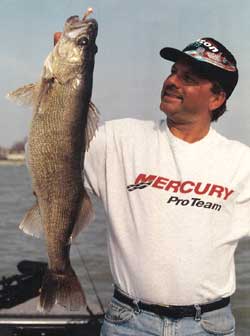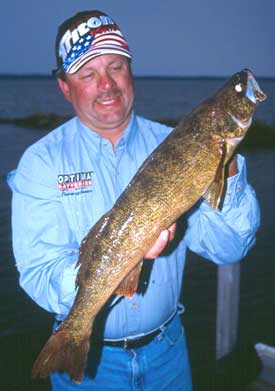 Picasso was a master of abstract art. Monet, van Gogh and Renoir were leading impressionists. Andy Warhol helped make pop art a genre.
Picasso was a master of abstract art. Monet, van Gogh and Renoir were leading impressionists. Andy Warhol helped make pop art a genre.
Walleye anglers are artists, too, especially with a spinning rod in our hand and a box of jigs at our disposal. We can mix and match colors, textures and materials. We can paint a broad landscape or bring life to an individual element. And we can impart an action on our work that can be irresistable to our audience.
Call it jig art, and consider the shallows as your canvas. That’s where you’ll find good numbers of walleyes this time of year with few critics among them. Those fish are there to enjoy your work. Actually, they are there to enjoy the smorgasboard of culinary delights that exist as the water warms, weed growth develops and critters ranging from baitfish and juvenile gamefish to leeches and crawdads seek their own sources of sustenance. And there’s no better way to reach them or to tempt them than casting jigs. In fact, if I were allowed but one method of fishing in late May and early June, I would cast jigs to shallow water. It’s simply my favorite way to catch fish.
Why cast jigs?
First of all, it’s often the best way to effectively reach fish that are cruising water less than six feet in depth without spooking them, whether it’s a rockpile, hump, shoreline, stump field, wingdam or weed edge where crankbaits would be constantly hung up or fouled.
Jigs are the right choice because they can be crafted to resemble a wide variety of the forage walleyes are after and because the angler can change their action by altering the method of retrieve. That’s where the artistry comes into play.
For most applications, a simple round-headed jig is the way to go. Follow the standard school of thought when selecting a color. On bright days, choose bright colors like chartreuse or white, and on darker days look more toward the blacks, blues and purples. In general, I like to use the lightest jig I can fish effectively. Typically, that means an eighth-ounce size, although there are times on flat, calm days when a 1/16th-ounce jig is the ticket. If there’s a lot of wood, weed or debris in my target area, I’ll switch from a standard round head to a Lindy Vegi-Jig that is relatively weedless.
Sometimes, it doesn’t make much difference how you work a jig through the shallows. If the fish are really on a feeding rampage, they will chase it down. At other times, anglers need to consider body styles, lure action, buoyancy and exactly what that jig is doing under the surface.
My standard warm-water jig is dressed with a 3- of 4-inch Kalin grub, although I may go to a 5-inch grub if I want a slower drop on the jig or if I’m targeting larger fish. I also keep a few ringworms on hand for those days when the fish are a bit more fussy.
 Hair jigs are another way to offer the fish a good-sized profile and to slow the rate of fall to give a walleye a better look. Jigging styles range from a straight swim retrieve to aggressive snap-jigging to a subtle lift-and-drop. The fish will tell you how they want it. Whether I add live bait to a jig depends on the weather and the level of activity I sense in the walleyes.
Hair jigs are another way to offer the fish a good-sized profile and to slow the rate of fall to give a walleye a better look. Jigging styles range from a straight swim retrieve to aggressive snap-jigging to a subtle lift-and-drop. The fish will tell you how they want it. Whether I add live bait to a jig depends on the weather and the level of activity I sense in the walleyes.
Cold fronts are a usually a signal to slow down and put something that wiggles and carries scent in front of the walleyes. I like a short-shanked jig because it makes the presentation more compact, and my first two bait options in early summer are always leeches and crawlers.
When I use crawlers, I’ve had far more success with a half-crawler than a whole one when I’m flipping and retrieving a jig. Besides reducing the problem of a whole crawler getting fouled up on the hook, it’s been my experience that when I get a bite on a half-crawler that’s moving slightly, the fish usually gets the hook in its mouth. That’s not always the case when there are six inches of worm hanging behind the jig.
In current situations, walleyes tend to position themselves in eddies or behind structure where they can ambush prey that is being carried downstream. It follows that the most effective way to target these fish is to cast upstream and let the current take your jig to the fish. Because it’s already moving, you probably won’t need to add much hop. A subtle lift and drop is often all it takes to trigger strikes.
Most of the time, I try to target sizeable areas when I’m casting jigs and work them from the periphery using my Optima-powered MinnKota Terrova bow-mount trolling motor. However, if an isolated rockpile or weed pocket seems to be holding most of the fish, it may be a better option to toss out an anchor and pinpoint your efforts. That can be true in current situations, too. There are times when anchoring your boat and flipping into eddies or casting from slack water to a current edge is much more productive than vertical jigging or drifting.
Your choice of equipment will play into your success. That includes the rod, reel and line you choose. I like a medium-action Quantum PT spinning rod that allows me to cast even the smallest jigs a considerable distance. Keeping your line diameter small will help with distance, too, and I prefer Yo-Zuri Hybrid because it’s also tough enough to work the snaggy shallows and fast enough, thanks to its low-stretch feature, for quick and powerful hooksets from a distance.
If you haven’t discovered your artistic side, grab a handful of jigs and get into the skinny water. There’s no greater feeling in fishing than the "thunk" of a heavy walleye inhaling a jig in shallow water. It’s also a great way to introduce young anglers and newcomers to the sport. It’s interactive, so it will help hone their basic rod-and-reel skills, it makes one think about what’s happening beneath the surface and what triggers a fish to strike, and it’s a great way to catch almost every species of gamefish in early summer. Whether it’s walleyes, bass, pike or panfish, they all spend a good share of their time in water less than six feet deep this time of year.
It’s jig art and you’re the painter. The underwater world is your canvas.










